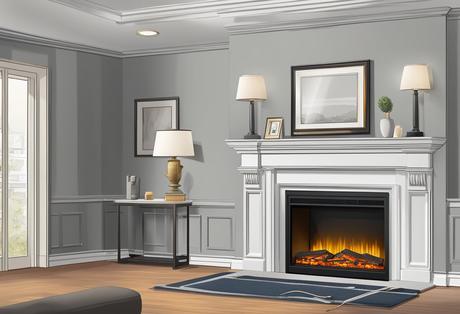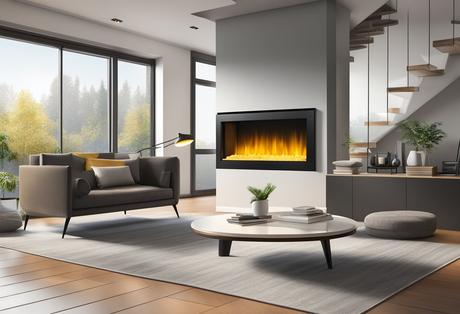Electric fireplaces provide the cozy ambiance and warmth of a traditional fireplace without the mess of ash and soot. They are a convenient and clean alternative, relying on electricity to generate heat and often come with LED lights to simulate flames.
To ensure they operate efficiently and safely, it is important for you to follow specific maintenance routines and safety precautions.

Key Takeaways
- Regular cleaning and correct use maintain your electric fireplace's efficiency.
- Installation and safety precautions are key to preventing electrical hazards.
- Proper maintenance ensures the longevity and safety of your electric fireplace.
Understanding Electric Fireplace Operation
When you incorporate an electric fireplace into your home, you get the cozy ambiance of traditional fireplaces without the need for chopping wood or dealing with fumes. Understanding the operation of electric fireplaces ensures you enjoy their warmth safely and efficiently.
Components of Electric Fireplaces
Your electric fireplace is composed of several main elements. At its heart, the heating element works much like an electric heater, turning electricity into heat. Above it, a light source, often an LED or light bulb, creates the illusion of flames.
This is enhanced by rotating mirrors that scatter the light, giving the appearance of a realistic flame flickering. Some models include artificial logs which aid in the real-fireplace effect. The entire system is controlled via a switch, or in some cases, a remote control, making operation simple and convenient.
Comparing Electric and Traditional Fireplaces
The primary difference between your electric fireplace and traditional ones, including wood-burning and gas fireplaces, is the source of heat. Electric fireplaces convert electricity directly to clean heat, while traditional fireplaces burn logs or gas to generate warmth.
A huge plus for electric models is that they emit no fumes, making them safer and more versatile for indoor use. They don't require a chimney or vent, so you can place them in any room.
Although they mimic the aesthetic of a real fire, electric fireplaces do not produce real flames, which significantly reduces fire hazards and makes maintenance a breeze.
Basic Safety Tips for Electric Fireplace Use
Electric fireplaces offer cozy warmth without the complexities of traditional fireplaces. Prioritizing safety ensures your comfort doesn't come with any unwelcome risks.
Locational Safety for Electric Fireplaces
Choosing the right spot for your electric fireplace involves more than aesthetics. Position it on a stable, level surface away from flammable materials like curtains or furniture. Always maintain a safe distance from combustibles, and ensure the unit isn't exposed to moisture. Plugging your electric fireplace directly into a wall outlet is best. Avoid using extension cords, as they can overheat.
Child and Pet Safety Near Electric Fireplaces
Your electric fireplace can be a great source of warmth, but it's important to keep it safe around children and pets. Install guards or gates to prevent accidental contact with the heated glass or elements. Additionally, ensure that the fireplace's controls are out of reach from curious hands or paws.
Regularly check the area for any debris or toys that might have been left by your little ones or furry friends.
Installation Guidelines for Electric Fireplaces
When installing your new electric fireplace, paying close attention to venting and electrical requirements is crucial for safe and efficient operation. These guidelines help you enjoy the warmth of your fireplace while ensuring everything is set up according to safety standards.
Proper Venting and Outlet Access
Your electric fireplace doesn't require a chimney, but it still needs proper clearance and ventilation to operate safely. Ensure that the location you choose allows for free air flow around the unit to prevent overheating. Additionally, the fireplace should be near an electrical outlet to avoid the use of extension cords, which can be a fire hazard.
- Clearance: Maintain at least 3 feet of clearance from drapes, furniture, and other flammable materials.
- Outlet: Plug your fireplace directly into a dedicated outlet.
Consulting Manufacturer Instructions
Each fireplace model has specific installation instructions provided by the manufacturer. You'll find crucial information such as the recommended distance from walls, the type of wall bracket needed, and guidelines for safely securing the unit. Always refer to the manufacturer's guide before starting your installation.
- Manual: Check the manual for diagrams and step-by-step instructions.
- Support: Contact the manufacturer or a professional if you have any questions during installation.
Routine Maintenance and Cleaning
Maintaining your electric fireplace ensures efficient operation and longevity. Regular cleaning reduces dust buildup and maintains the aesthetic appeal of your cozy home addition.
Cleaning Exterior Surfaces
Begin with the exterior of your electric fireplace. Use a soft, damp cloth to wipe down the outside, avoiding abrasive cleaners that may damage the finish. Regularly dusting the exterior not only keeps your fireplace looking great but also prevents debris from entering the internal components.
Internal Components Maintenance
Your electric fireplace's internal components are pivotal to its functionality. Ensure the unit is off and cool before opening the access panel.
Once inside, lightly dust around the heating elements and fan to keep them clear of debris. Inspecting the interior for any signs of damage or wear should be part of your ongoing maintenance.
Inspecting Electrical Connections
Safety is paramount when checking electrical connections. Ensure your fireplace is off and unplugged before beginning your inspection. Look for any loose wires or faulty switches, and if you're unsure about what you see, consult a professional.
Regular inspections can help prevent electrical hazards and keep your electric fireplace running smoothly.
Ensuring Longevity and Efficiency

Maintaining your electric fireplace properly will help to ensure it performs efficiently and enjoys a long lifespan. By taking a few straightforward steps focused on cooling, energy use, and timely replacement of parts, you can enjoy cozy warmth without unnecessary expense or hassle.
Avoiding Overheating and Ensuring Proper Airflow
To prevent your electric fireplace from overheating, make certain there's adequate ventilation around the unit. This means you should keep a clear space around the vents to promote good airflow, essential for heat distribution and motor longevity. Regularly check and remove any dust or debris that might block these vents, as restricted airflow can lead to overheating and reduced performance.
Maximizing Energy Efficiency
To operate your electric fireplace at peak energy efficiency:
- Use LED light bulbs if your model has a flame feature, as they consume less power and have a long lifespan.
- Set the heating level appropriately, so you're not using excess power to generate unneeded heat.
- Consider installing a programmable thermostat to control the temperature and conserve energy when you're not around to enjoy the warmth.
Replacing Parts Timely
Keep an eye on the condition of replaceable parts, such as light bulbs and the fireplace's motor. Swapping out these parts before they fail helps maintain the unit's efficiency and prevents larger issues.
Planning the replacement of worn-out components can thus contribute to both optimal performance and an extended lifespan for your electric fireplace.
Safeguarding Against Potential Hazards
Ensuring your electric fireplace is functioning safely is crucial to prevent potential accidents and fire hazards. Paying attention to early signs of malfunction can help you avert the release of harmful gases or other dangerous situations.
Preventing Accidents and Fire Hazards
You should regularly check your electric fireplace for signs of soot or creosote buildup, which can be fire hazards. It's vital to clean these residues using non-abrasive cleaners to maintain the fireplace's safety and efficiency. Also, ensure that flammable items are kept at a safe distance to avoid any accidents.
- Maintenance Tips:
- Clean regularly: Wipe the glass door and exterior with a soft cloth to remove dust and avoid soot accumulation.
- Inspect barriers: Check the glass door for cracks that could lead to smoke escaping or accidental burns.
Invest in smoke and carbon monoxide detectors for added safety. These alarms will alert you promptly in case of any smoke or harmful gases, such as carbon monoxide, which can be a concern for individuals with respiratory issues like asthma. Moreover, adhering to established safety standards should be a cornerstone of your maintenance routine.
Dealing with Electric Fireplace Malfunctions
When your electric fireplace malfunctions, first ensure that the appliance is unplugged to prevent electrical accidents. Check the fuse to verify if it's blown and replace it if necessary. If your fireplace has a load-bearing timer, verify that it's set correctly to avoid overheating.
- Troubleshooting Tips:
- Check the fuse: A blown fuse is a common issue that can halt the operation of your electric fireplace.
- Monitor space heater elements: If your electric fireplace includes a space heater, observe for any abnormal functioning.
If your fireplace continues to malfunction, seek professional assistance rather than trying to fix complex issues by yourself. Regular maintenance checks can often prevent these malfunctions, ensuring your fireplace remains a safe and cozy feature in your home.
Specialized Maintenance Procedures
Regular maintenance keeps your electric fireplace running efficiently and safely. This section guides you through the detailed processes needed to ensure optimal performance and safety of your unit.
Annual Inspections and Professional Cleanings
Your electric fireplace benefits greatly from a yearly professional inspection and cleaning.
A certified technician can spot any early signs of wear and ensure all components are in top condition. During these visits, expect a thorough cleaning, which can extend the lifespan of your fireplace and maintain its safe operation. Always refer to your manufacturer's guidelines to align with their recommended practices.
- Annual Inspection Checklist:
- Verify safety features are functioning correctly.
- Check for any damage or wear on the fireplace components.
- Ensure proper operation of the unit.
Assessing and Replacing Heating Elements
The heating element in your electric fireplace is pivotal to its performance. Annually assess the condition of your heating elements for accumulated dust and debris, as this can impact their effectiveness. If you notice signs of damage or if they're not working as efficiently, consider having them replaced. Replacement should be done in accordance with the manufacturer's specifications, and might often be a job for a professional to ensure your safety and the fireplace's continued proper operation.
- When to Replace Heating Elements:
- Decreased heat output
- Visible damage or wear
- After a specified number of usage hours, as recommended by the manufacturer
Frequently Asked Questions
Ensuring the longevity and safety of your electric fireplace involves regular maintenance and being aware of the proper procedures. Here's what you need to know.
How often should I perform maintenance checks on my electric fireplace?
You should inspect your electric fireplace at least once a year to ensure everything is functioning correctly. Before the colder months is an ideal time for this check-up.
What are the essential steps for cleaning an electric fireplace?
To clean your electric fireplace, turn it off and let it cool. Then, remove any dust or debris using a soft cloth. Avoid using abrasive cleaners that can damage the surface or internal components.
Can I use household cleaners on my electric fireplace, and if so, which ones?
Yes, you can use mild household cleaners on your electric fireplace. Choose cleaners that are non-abrasive and designed for electronics or glass to prevent damage to the surfaces.
Are there any specific parts of an electric fireplace that need regular attention?
Pay special attention to the heater's vents and fans. Keeping these areas clean and clear is crucial for preventing overheating and maintaining efficient operation.
What safety measures should I follow when operating my electric fireplace to prevent accidents?
Always monitor the fireplace when it's in use, especially around children and pets. Never leave it running unattended or while asleep, and ensure that the area around the fireplace is free of flammable materials.
What are the signs that indicate my electric fireplace may need professional servicing?
If you notice unusual noises, smells, or a decline in heating efficiency, it might be time for professional servicing. Also, if the fireplace's safety features trigger without an apparent cause, seek expert advice.
